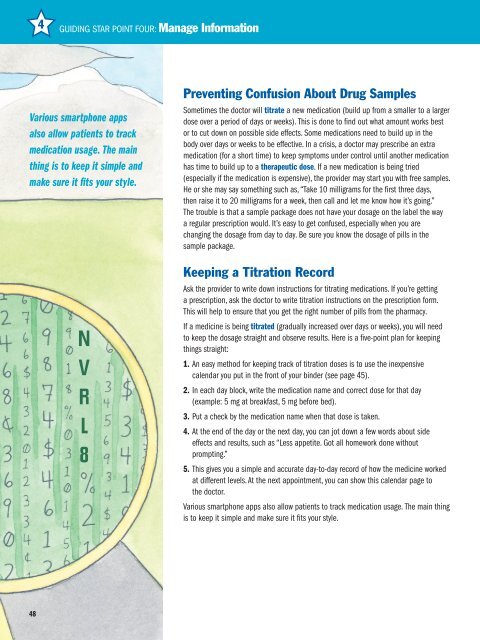Look Inside Young Adult Road Map
You also want an ePaper? Increase the reach of your titles
YUMPU automatically turns print PDFs into web optimized ePapers that Google loves.
4<br />
Guiding Star Point four: Manage Information<br />
Various smartphone apps<br />
also allow patients to track<br />
medication usage. The main<br />
thing is to keep it simple and<br />
make sure it fits your style.<br />
N<br />
V<br />
R<br />
L<br />
8<br />
Preventing Confusion About Drug Samples<br />
Sometimes the doctor will titrate a new medication (build up from a smaller to a larger<br />
dose over a period of days or weeks). This is done to find out what amount works best<br />
or to cut down on possible side effects. Some medications need to build up in the<br />
body over days or weeks to be effective. In a crisis, a doctor may prescribe an extra<br />
medication (for a short time) to keep symptoms under control until another medication<br />
has time to build up to a therapeutic dose. If a new medication is being tried<br />
(especially if the medication is expensive), the provider may start you with free samples.<br />
He or she may say something such as, “Take 10 milligrams for the first three days,<br />
then raise it to 20 milligrams for a week, then call and let me know how it’s going.”<br />
The trouble is that a sample package does not have your dosage on the label the way<br />
a regular prescription would. It’s easy to get confused, especially when you are<br />
changing the dosage from day to day. Be sure you know the dosage of pills in the<br />
sample package.<br />
Keeping a Titration Record<br />
Ask the provider to write down instructions for titrating medications. If you’re getting<br />
a prescription, ask the doctor to write titration instructions on the prescription form.<br />
This will help to ensure that you get the right number of pills from the pharmacy.<br />
If a medicine is being titrated (gradually increased over days or weeks), you will need<br />
to keep the dosage straight and observe results. Here is a five-point plan for keeping<br />
things straight:<br />
1. An easy method for keeping track of titration doses is to use the inexpensive<br />
calendar you put in the front of your binder (see page 45).<br />
2. In each day block, write the medication name and correct dose for that day<br />
(example: 5 mg at breakfast, 5 mg before bed).<br />
3. Put a check by the medication name when that dose is taken.<br />
4. At the end of the day or the next day, you can jot down a few words about side<br />
effects and results, such as “Less appetite. Got all homework done without<br />
prompting.”<br />
5. This gives you a simple and accurate day-to-day record of how the medicine worked<br />
at different levels. At the next appointment, you can show this calendar page to<br />
the doctor.<br />
Various smartphone apps also allow patients to track medication usage. The main thing<br />
is to keep it simple and make sure it fits your style.<br />
48














